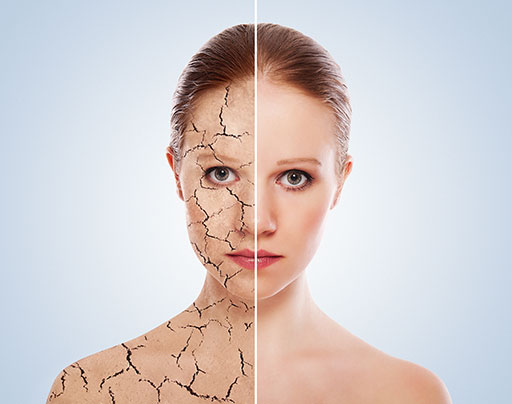Skin & Hair
Find out what you and your loved ones can do to improve your skin's health and appearance, as well as prevent serious conditions such as skin cancer. In this center you will find the answers to your concerns on all procedures, tests and surgeries for skin- and hair-related conditions.

Featured Topics

Proper skin care is vital to good health and techniques such as shaving and piercing are forms of personal expression. Skin damage can occur through sun exposure, smoke exposure or frostbite (associated with extreme cold) as well as daily life (e.g., corns, bunions and calluses). Skin trauma (or injury) may include bite wounds, bruises, burns and cuts or other common wounds. Sunscreens can help prevent damage. This is most important in patients who are sensitive to sunlight (photosensitivity) such as xeroderma pigmentosum or polymorphous light eruption. Proper diet can also promote skin health.
- Dandruff
- Diet & Skin Health
- Dry Skin
- Facial Skin Basics
- Photosensitivity
- Phototherapy
- Shaving
- Skin Basics
- Skin Care
- Skin Trauma
- Sun Exposure
- Sunscreens
- Xeroderma Pigmentosum

Aging causes many skin changes, including sags, wrinkles and altered texture. Medications and procedures can improve the skin's appearance, a process known as facial skin rejuvenation. Damaged skin may be removed (such as through chemical peels and laser resurfacing) or enhanced (such as through Botox injections, soft tissue augmentation, blepharoplasty or fat transfer).
- Aging & the Skin
- Blepharoplasty
- Botox
- Chemical Peels
- Facial Skin Rejuvenation
- Liposuction
- Spider Veins
Hair Loss
Alopecia (hair loss) is a condition that affects many men and some women. In cases of male pattern hair loss or female pattern hair loss, it is a natural process. However, in some cases a disorder or illness such as alopecia areata or telogen effluvium may be responsible.
- Alopecia Areata
- Female Pattern Hair Loss
- Hair Loss Basics
- Hair Restoration
- Male Pattern Hair Loss
Learn more about Skin & Hair
Acne & Blemish
Acne and blemishes are among the most common skin disorders. Typically, people experience outbreaks of blackheads and whiteheads. In other cases, people may experience slightly different skin conditions, such as keratosis pilaris or rosacea. Acne medications such as retinoids can help reduce symptoms. In severe cases, acne surgery may be necessary to help clear skin.
- Acne
- Acne Medications
- Keratosis Pilaris
- Rosacea
Skin Signs & Symptoms
There are many different signs and symptoms that may indicate an underlying skin disorder. Some - such as skin rash, pruritus, anal itching, skin boils, moles, ulcers and bruised hands and arms — can indicate many different types of conditions, ranging from those that are relatively harmless to more serious disorders. Some signs are strongly indicative of certain disorders, such as erythema marginatum (which indicates rheumatic fever) or erythema migrans (which indicates Lyme disease). Other signs and symptoms are particular to a person's nails, such as brittle splitting nails and onycholysis.
- Anal Itching
- Brittle Splitting Nails
- Bruising Hands & Arms
- Pressure Ulcer
- Pruritus
- Shingles
- Skin Boils
- Skin Rash
Dermatitis, Eczema & Hives
Dermatitis and hives cause varying levels of skin reddening and inflammation. Examples of dermatitis, sometimes called eczema, include atopic dermatitis, seborrheic dermatitis and perioral dermatitis. Contact dermatitis results from an allergen (allergic contact dermatitis) or irritant (irritant contact dermatitis). Hives are smooth bumps that suddenly appear on the body.
- Angioedema
- Atopic Dermatitis
- Contact Dermatitis
- Diaper Rash
- Eczema
- Eczema & Children
- Hives
- Plant Dermatitis
- Seborrheic Dermatitis
- Swimmer Itch
Skin Surgery
Laser surgery, cryosurgery, electrodesiccation and curettage, and intralesional injections are skin surgeries that treat skin problems that are not cosmetic in nature. Laser hair removal and tattoo removal often are used for cosmetic purposes. Some kinds of surgery (e.g., plastic surgery, skin grafting) may be either cosmetic or medically necessary.
- Dermabrasion
- Laser Hair Removal
- Laser Skin Surgery
- Plastic Surgery
- Tattoo Removal
Psoriasis & Autoimmune Skin
Autoimmune skin diseases sometimes pose a serious health threat and may cause symptoms such as skin blisters or rashes. Psoriasis is a common skin disorder characterized by patches of raised, inflamed lesions. Conditions such as epidermolysis bullosa may range from very mild to potentially life-threatening while diseases such as scleroderma are potentially disfiguring.
- Dermatomyositis
- Epidermolysis Bullosa
- Pemphigus
- Psoriasis
- Psoriasis Medications
- Scleroderma
Skin Growths
Some skin growths are cancerous, such as those related to Bowen disease. Most are benign, such as angiomas, prurigo nodularis, pyogenic granuloma, steatocystoma multiplex and seborrheic keratoses. Some growths, such as keratoacanthomas, resemble cancerous tumors and should be checked by a physician. Growths may resemble rashes with raised bumps or scarring, such as keloids.
- Keloids & Hypertrophic Scars
- Warts
Skin Discoloration
Skin discoloration results from several factors. Some are natural, such as birthmarks. Others are related to factors such as sun exposure (e.g., disseminated superficial actinic porokeratosis, hyperpigmentation) or allergy or immune reaction (lichen planus). The skin can become darker (e.g., acanthosis nigricans, progressive pigmentary purpura) or lighter (albinism, vitiligo).
- Acanthosis Nigricans
- Albinism
- Lichen Planus
- Necrobiosis Lipoidica
- Vitiligo
Perspiration & Chafing
Skin discoloration results from several factors. Some are natural, such as birthmarks. Others are related to factors such as sun exposure (e.g., disseminated superficial actinic porokeratosis, hyperpigmentation) or allergy or immune reaction (lichen planus). The skin can become darker (e.g., acanthosis nigricans, progressive pigmentary purpura) or lighter (albinism, vitiligo).
- Chafing
- Hidradenitis Suppurativa
- Hyperhidrosis
- Perspiration
